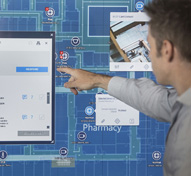Honeywell has announced the next generation of smart building technology, Command and Control Suite. The company says that it turns complex facility data into recommendations and changes that help boost business outcomes — lowering costs, minimising risk and reducing downtime.
By combining intelligent automation, analytics and visualisation with the user experience of today’s home and mobile electronics, Command and Control Suite links building automation. It provides a holistic view of a connected building’s video feeds, access control and fire alarms, for example, and pulls in relevant information from human resource applications. Integrating data from these disparate systems could help security staff track occupants and make sure they exit the facility in the event of an evacuation, improving employee safety.
Investing in this type of smart building technology typically pays for itself within one or two years by delivering operational efficiencies as well as energy savings, according to a recent report by Jones Lang LaSalle, a financial and professional services firm.
Benjamin Freas, senior research analyst at Navigant Research, said: “The building data currently collected in modern facilities presents a vast opportunity to reduce operations and maintenance costs. However, difficulties in integrating data from separate building automation systems have encumbered realising this potential. The usability of facility technologies has been a persistent challenge as well. To date, success in system performance has largely been dependent on the skill and experience of operators.”
Guided by the Honeywell Design Studio, all components of the Command and Control Suite were built with the intuitive style of tablets and smartphones, making the technology accessible to a facility manager and chief operating officer. Because virtually anyone can understand and act on the insights the command suite provides, companies can improve business continuity and efficiency, and get a higher return on investment, the makers say. A refined user experience helps reduce operator training and related expenses.
The Honeywell Command Wall, the core of the suite, features map-based visualisation and navigation, with integrated workflows and system-wide integration from a single, intuitive touchscreen interface. The Command Wall presents data from multiple systems across a facility, such as utility meters and temperature sensors, while providing context for more informed decision making. Using progressive disclosure, users can access an enterprise-wide view and also easily zoom into specific areas to quickly understand and react to issues and opportunities as they arise.
John Rajchert, president of Honeywell Building Solutions, said: “A building’s intelligence is largely influenced by those who operate it and can make the changes necessary to improve performance, so enhancing the user experience is imperative. It allows organisations to extract the most value from their technology investment. Like today’s ubiquitous tablet and mobile devices, Command Wall makes connecting with information and others fast and simple.”
A supplement to the Command Wall is Incident Workflow, which guides users step by step through scripted responses to security incidents and other emergencies, helping further reduce risk and improving accuracy in mitigating issues. Enterprise Dashboards extend the suite’s real-time visualisation by presenting detailed energy data and actionable guidance to help control consumption.
Command and Control Suite technologies integrate with Honeywell’s flagship building management platform, Enterprise Buildings Integrator (EBI), which helps integrate security, comfort, life safety and energy systems, among other functions. EBI gives users a single point of access and consistent view to information and resources that enhance the ability to monitor, manage and protect a facility, campus or multi-site operation.
The Command Wall with Incident Workflow and Enterprise Dashboards will be available in the second quarter of 2015.










